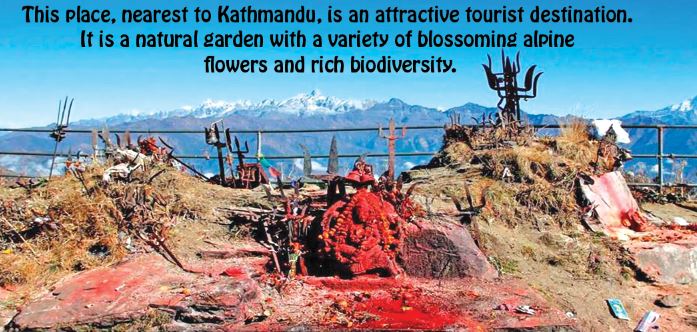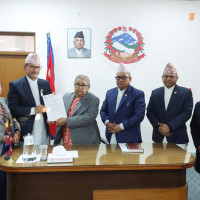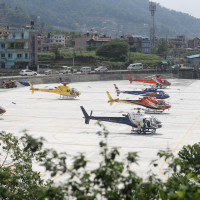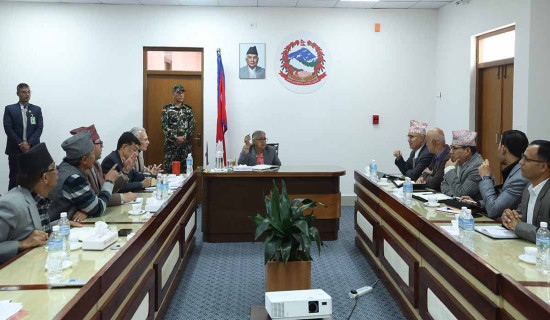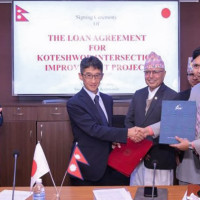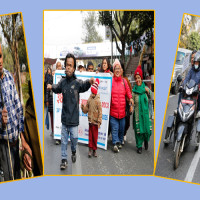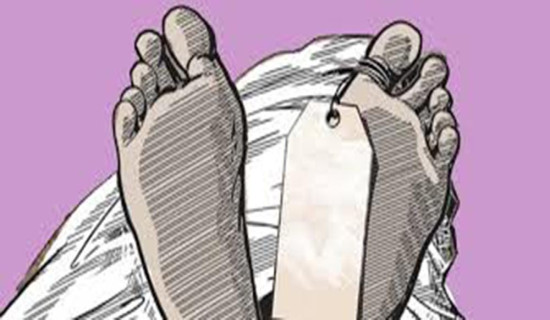- Thursday, 4 December 2025
Goddess On The Hill
Prof. Shyam Joshi
Winter Snow
This place is covered with snow during winter. But in the months between Baisakha and Bhadra, there are many beautiful varieties of wildflowers. Different varieties of aromatic flowers and medicinal plants can be found here. This is why the people of Dolakha believe that this place is the abode of gods and goddesses. There is a three-storey cave in the Tutan area where pilgrims used to take shelter at night in the past.
On the top of the hill, there is a small temple of the goddess Kalinchok Bhagawati. Although the temple premise is very narrow thousands of devotees assemble here during festivals. There is no image of a goddess inside the temple, surrounded by Trisuls and bells offered by pilgrims. There is only a small water - pit (jalkund) of about three feet in depth which is worshipped as Kalinchok Bhagawati., The animal sacrifice of goat and cock are not made on the "Kund", instead made on the stone image of Lord Ganesh situated to the north of the temple. In the past, people of the Newar community of some of the areas of Dolakha town worked as the priest (Pujari) of the temple.
It is believed that the goddess blesses her devotees with whatever they demand from good health to economic prosperity. Therefore, people gather here from far and wide for certain festivals held here such as Janai Purnima and Kartik Purnima. The pilgrims feel a bit difficult to go upward to the temple from Tutan due to increasing elevation. Hence, by the way of joke that part of the road is called "Papidada", and thus, it is said by the way of joke that sinners cannot go upward. Now this problem has been solved by the provision of the cable car.
Origin of the goddess
It is said that among the trio of sisters Kalinchok Bhagawati chooses to stay at the beautiful hill of Kalinchok, whereas two other sisters, Tripurasundari and Balkumari choose to stay in Dolakha town. There is a legend regarding the origin of Kalinchok Bhagawati. According to elderly locals there used to be many sheepcotes in the Kalinchok area. A flock of sheep used to assemble in the temple area and used to lick the stones and dig the soil regularly every day. Finally, shepherds found the water - pit (Jalkund) made visible by the licking and digging of the sheep.
Thereafter people began to worship the water - pit as goddess Kalinchok Bhagawati. This pit is small but always full of water. There are several myths linked to this water- pit. It is believed that the water of this "Jalkund" comes to the holy water- pit called Nirmal beneath the image of lord Bhimeswor located at Dolakha town. There is also a myth that this very water pit is the source of the Tamakoshi River flowing to the east and the Sunkoshi River flowing to the west of Kalinchok Bhagawati temple.
In the period between Baisakha and Bhadra this place is crowded with pilgrims for two reasons - to see the beautiful scenery including the shrine of Mt. Gaurishankar, and to worship the goddess Kalinchok Bhagwati. It is said that before the great earthquake of 1990 B.S. the Dharahara tower in Kathmandu could be seen from the hill when the sky would be clear.
Heaven On Earth
This place, nearest to Kathmandu, is an attractive tourist destination. It is a natural garden with a variety of blossoming alpine flowers and rich biodiversity. It is thus advisable to visit this place during April and May. This is why some people, after the visit to this place, remark – "The heaven is a myth but the beauty of Kalinchok is a reality". It’s a breathtaking experience to pay homage to the deity on the top of the hill.
Rhododendrons of various colours including the red Rhododendron, the national flower of Nepal, can be seen in this area. The Blossoming of these flowers presents a heart touching scene. The flowers blossom in the month of Baisakha, that is, in mid-April.
The tourists can enjoy the panoramic and majestic view of MT. Gaurishankar (7134 metres above sea level) and other mountain peaks, such as Ganesh Himal. Dorjelakpa, Melungse and so on from the Kalinchok hill.
Those who love to see and play on snow may visit the area during winter when there is heavy snowfall. Due to the availability of transport, lodging and food facilities it is far easier now to visit this area even in winter.
The hill where the temple is located is linked to another hill, to the west of the temple, by an iron staircase-shaped bridge. This bridge has a length of 22 feet, and a breadth of 4 feet with 22 steps. This bridge was built by commanding General Fouda Singh Khatri of Magadeurali of Dolakha district at the time of the reign of Shree 3 Bir Samasher JBR.
In past, some of the villages of the Kalinchok area had been given to the people of certain localities in Dolakha town as Guthi land to perform regular worship of Kalinchok Bhagawati and other prominent deities of Dolakha including Tripurasundari and Bhimeswor. The available written document shows that this system was continued later by His Majesty Rajendra Bikram Shah in 1886 B.S. So the Guthiyars (trustees) used to go there to raise revenue once a year and would return with rice pudding (kheer) since tenants used to give milk from their cowsheds. However, the trustees of Dolakha have now lost their ownership due to the illegal occupation of these lands.
During the Janai Purnima festival, devotees visit the temple for worship and animal sacrifices. On the same occasion, a group of people known as "Rapakhalak" from the lower and upper localities of Dolakha town go to Kalinchok, worship the goddess and return the next day. It is said that they pray for the blessing of the goddess Bhagawati to kill the demon giving trouble to the people of Dolakha. Upon returning from the temple these groups, with typical flags as a symbol of victory, take a walk around all the temples within Dolakha town playing classical music.
How To Get There
People who like to watch snowfall and play on snow can visit during winter but to watch the real beauty of nature with a variety of blossoming flowers it is better to visit during April - May. Besides being an attractive tourist destination, the road to Kalinchok is still fair-weather. Kalinchok is 17 km from Charikot, the district headquarter of Dolakha district. Charikot, (2000 metres above sea level), is 130 km from Kathmandu and can be reached in 6 hours by local bus and 4 hours by private car and jeep.
Thus, Kalinchok is within an hour's drive up to Kuri, a base camp or last stop from Charikot. Jeeps like Bolero are easily available in Charikot for rent. Many restaurants, hotels and lodges are easily available in Kalinchok at affordable prices. There are many travel agencies conducting package tour, which includes Bhimeswor temple in Dolakha town (1700 metre above sea level) as well as Kalinchok Bhagawati temple.
(The author is an expert on culture)

